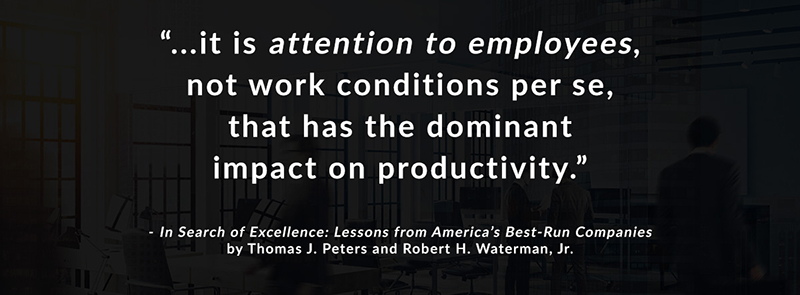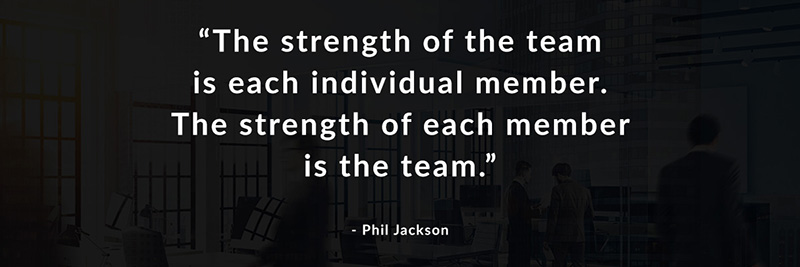
Have you heard of the management strategy called MBWA…or “management by walking around”? The idea is that you learn the most about your employees, your business, and their collective needs by walking around and interacting with them. In other words, it's better to get up and get moving than sit behind a desk and wait for the TPS reports to pile up.

The concept of management by walking around isn’t new. It’s credited to Bill Hewlett and David Packard, and Steve Jobs famously used it at Apple. It was mentioned frequently in the 1982 book In Search of Excellence: Lessons from America’s Best-Run Companies by Tom Peters and Robert Waterman. In that book, they call MBWA “the technology of the obvious.”
But is it still obvious?
Proponents of management by walking around like the face-to-face interaction it requires. With so many options for texting, chatting, and emailing these days, it’s easy for managers and employees to keep each other at arm’s length. Good old-fashioned water cooler chat is the antidote to a hyper-connected workplace that leaves everyone feeling a little…disconnected.
In our office, you can often find Jan and Ryan Pinney walking around, saying hi, and asking what you did over the weekend. We talk about our hobbies, family, friends, and what we’re working on. Not every conversation hits on all these things, but they develop over time.
In our office, MBWA just plain works. Here’s Ryan to explain why.
Reason #1: Morale Boosting
Because this is an informal method of talking, employees feel they can open up and be honest. You become more than just the manager. You become someone they know and like and trust. For them, the benefit is a relaxed and comfortable work environment. That’s a benefit for me as a manager, too, but now I get a second benefit - my team members are more likely to tell me about problems affecting their work. If your employees only see you in the context of a weekly meeting or formal review, they’re less likely to come to you with these problems.
Walking around and chatting builds rapport outside the confines of a formal review process. You’re not just someone behind an imposing desk. You’re someone they can talk to.
Watch out for the Potential Down Side of Informality
As you get to know your employees, you’ll probably learn that some have similar hobbies and interests, or mutual friends in common with you. It’s up to you whether you decide to pursue that as a friendship outside the office. Be aware that this could create too informal a relationship, which may lead to problems back in the office. Would it be a bad thing for your working relationship to meet up with an employee on the golf course? Or catch the same movie you’ve both been dying to see? As the manager, you have to weigh this decision carefully before proceeding.

Reason #2: Relationship Building
When you talk to people during the workday, you learn things they might not tell you if you weren’t witnessing them as they happen. I’ve been there to see an employee struggling with a death in the family. Because I was there, in that moment, I could tell her to go home and take the time she needed. Another time, I found out about an employee’s pregnancy. Normally, I might not have known until there was a baby shower announcement. Because I knew, I could congratulate her and go back to ask how she was doing the next time I walked around.
As a manager, this is your time to shine. You get to experience your employees’ lives as they happen. You’ll get to see the good and the bad, but it’s always a valuable experience.

Reason #3: Problem Identification
Both points mentioned above are about employee relationships, but you can also learn about your company. If you’re standing next to someone while they do their job and something goes wrong, they’re going to tell you about it. What happened? Is there a problem with your system? Is something not working the way it should?
I experience this with Insureio on a regular basis. New features, upgrades, and bug fixes change the way the system works, and sometimes things happen that we don’t anticipate. When employees find a bug or something doesn’t work the way it should, they often find workarounds to keep on track.
More often than not, I don’t know about these workarounds until I see them being used. But when I know about them, I can fix the system and save every employee a few seconds or a couple clicks. Over time, these little things add up. As a manager, I’d much rather people come tell me about little system inefficiencies like this, but it doesn’t always happen. The great thing about management by walking around is that I see them in action and I can do something about it.
This holds true for systems large and small. You might not be managing many employees or be building a CRM from the ground up. But chances are you have a system and a set of tools. What happens when that system or one of your tools stops working? Would you rather learn about it in a weekly or monthly staff meeting…or would you rather see it for yourself when it happens?

4 Tips for Management by Walking Around
Want to incorporate MBWA into your management routine? It's easy - as long as you establish goals first. Do you want to create a friendly, relaxed working environment? Or do you want to conduct informal Q&A sessions where employees give feedback and ask questions? Both are valid strategies, and a mix of both may work best for your business.

#1: Super busy? Schedule time for it – but not at a fixed date or time.
The whole point of management by walking around is to mingle and get a feel for your office’s mood. This is easiest to achieve when it’s spontaneous. If your employees know you swing by at 8:30 am every Monday and Friday morning, they may prepare for your visit.
If you’re swamped and just can’t break away, treat MBWA like any other necessary meeting. Create a morning calendar reminder that prompts you to schedule a time later that day. Since your calls and meetings probably vary, you’ll naturally pick different times of day for your walk each time your morning reminder prompts you to do so. Be sure you follow through and actually get up and walk when your appointment reminder tells you it’s time.
#2: Be positive and helpful.
MBWA is not the time to criticize or nitpick, unless you see something going incredibly wrong. If you see something you don’t like, circle back to that employee or team later and talk about it behind closed doors.
#3: Answer questions.
Even if your goal is to chat, you may get peppered with questions from employees. Answer them on the spot if you can. If you don’t know the answer, be sure you get back to them. If you leave the question unanswered, your employees will learn not to ask, and that defeats the goal of improving communication. It may help to jot things down during your walk or record voice memos on your phone.
#4: Keep doing it.
If you stop after a week or a month, what kind of message does that send to your team? They may think you were only checking up on them for a short period of time, or that you have better things to do. Consistency is important for MBWA. You don’t have to do it every day, but once you pick a schedule (daily, weekly, twice weekly, etc.), stick with it.
